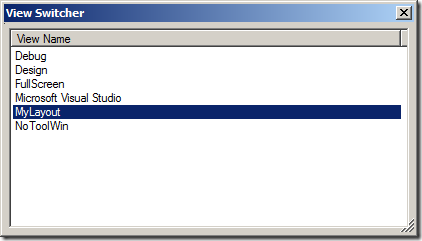Save and Change Tool Layout in Visual Studio
Reading time ~9 minutes
There have been many people who have asked for a way to save window positions within Visual Studio. For example they layout all their tool windows in a particular order and wish to change it based on the task at hand, but want to get back to the original setup.
Previously when asked, I recommended an old add-in and always suggested they update the code for 2008. I got tired of that recommendation, I needed the ability, and I needed it in 2010.So I wrote the following macro to allow a developer to Save, Switch, and Delete window/tool positions within Visual Studio.
The Macros names are pretty self-describing but here is a screen shot of it in action:

As always if you want to bind it to a keyboard shortcut go to Tools–>Options–>Environment—>Keyboard. Then in the ‘show commands containing’ box type one of the following: SwitchCurrentView, SaveCurrentView, DeleteSavedView and bind to a shortcut key. (Try - CTRL+ALT+0)
Tested on VS2008 and VS2010 should work in VS2005
Create a new macro module called ‘View’ and paste in the following: (You may need to add a reference to System.Drawing)
Imports System
Imports EnvDTE
Imports System.Collections.Generic
Imports System.Windows.FormsPublic
Module View
Sub SaveCurrentView()
Dim viewName As String
viewName = InputBox("Name your view:", "Save view layout")
If Not String.IsNullOrEmpty(viewName) Then
DTE.WindowConfigurations.Add(viewName)
End If
End Sub
Sub SwitchCurrentView()
Using frm As New frmViewSwitcher
Dim winptr As WinWrapper = New WinWrapper
Dim ret As DialogResult
Try
ret = frm.ShowDialog(winptr)
If ret = DialogResult.Cancel Then
Exit Sub
End If
DTE.WindowConfigurations.Item(frm.SelectedView).Apply()
Catch ex As Exception
MsgBox(ex.Message)
Finally
ret = Nothing
winptr = Nothing
End Try
End Using
End Sub
Sub DeleteSavedView()
Using frm As New frmViewSwitcher
frm.Name = "Delete View"
Dim winptr As WinWrapper = New WinWrapper
Dim ret As DialogResult
Try
ret = frm.ShowDialog(winptr)
If ret = DialogResult.Cancel Then
Exit Sub
End If
Dim currentView As String = DTE.WindowConfigurations.ActiveConfigurationName
Dim selectedView As String = frm.SelectedView
If Not String.Compare(currentView, selectedView, True) = 0 Then
Dim conf As WindowConfiguration = DTE.WindowConfigurations.Item(frm.SelectedView)
conf.Delete()
Else
MsgBox("Cannot delete current view!", MsgBoxStyle.Critical + MsgBoxStyle.OkOnly, "Current View")
End If
Catch ex As Exception
MsgBox(ex.Message)
Finally
ret = Nothing
winptr = Nothing
End Try
End Using
End Sub
End Module
Partial Class frmViewSwitcher
Inherits System.Windows.Forms.Form
Implements IDisposable
Private _viewList As List(Of String)
Public Sub New()
InitializeComponent()
_viewList = GetViews()
_viewList.Sort()
For Each v As String In _viewList
lstResults.Items.Add(v)
Next
lstResults.Items(0).Selected = True
Me.Focus()
End Sub
WriteOnly Property Name() As String
Set(ByVal value As String)
Me.Text = value
End Set
End Property
Private Function GetViews() As List(Of String)
Dim rtnList As New List(Of String)
For Each wc As WindowConfiguration In DTE.WindowConfigurations
Dim viewName As String = wc.Name
rtnList.Add(viewName)
Next
Return rtnList
End Function
Public ReadOnly Property SelectedView() As String
Get
Return lstResults.SelectedItems(0).Text
End Get
End Property
Protected Overrides Sub Dispose(ByVal disposing As Boolean)
Try
If disposing AndAlso components IsNot Nothing Then
components.Dispose()
End If
Finally
MyBase.Dispose(disposing)
End Try
End Sub
Private Const ControlWidth As Int16 = 400
Private Const ListHeight As Int16 = 200
Private Const Padding As Int16 = 5
Private Const WindowHeight As Int16 = Padding + ListHeight + Padding
Private Const WindowWidth As Int16 = Padding + ControlWidth + Padding
Private components As System.ComponentModel.IContainer
Private Sub InitializeComponent()
Me.lstResults = New System.Windows.Forms.ListView
Me.colViewName = New System.Windows.Forms.ColumnHeader
Me.colViewName.Text = "View Name"
Me.button = New System.Windows.Forms.Button
Me.SuspendLayout()
Me.lstResults.Anchor = CType((((System.Windows.Forms.AnchorStyles.Top Or System.Windows.Forms.AnchorStyles.Bottom) _
Or System.Windows.Forms.AnchorStyles.Left) _
Or System.Windows.Forms.AnchorStyles.Right), System.Windows.Forms.AnchorStyles)
Me.lstResults.Columns.AddRange(New System.Windows.Forms.ColumnHeader() {Me.colViewName})
Me.lstResults.FullRowSelect = True
Me.lstResults.HideSelection = False
Me.lstResults.Location = New System.Drawing.Point(Padding, Padding)
Me.lstResults.MultiSelect = False
Me.lstResults.Name = "lstResults"
Me.lstResults.Size = New System.Drawing.Size(ControlWidth, ListHeight)
Me.lstResults.TabIndex = 1
Me.lstResults.UseCompatibleStateImageBehavior = False
Me.lstResults.View = System.Windows.Forms.View.Details
Me.colViewName.Width = CInt(lstResults.Width - 10)
Me.button.DialogResult = System.Windows.Forms.DialogResult.Cancel
Me.button.Size = New System.Drawing.Size(1, 1)
Me.AllowDrop = False
Me.AutoScaleDimensions = New System.Drawing.SizeF(6.0!, 13.0!)
Me.AutoScaleMode = System.Windows.Forms.AutoScaleMode.Font
Me.ClientSize = New System.Drawing.Size(WindowWidth, WindowHeight)
Me.Controls.Add(Me.lstResults)
Me.Controls.Add(Me.button)
Me.CancelButton = Me.button
Me.MaximizeBox = False
Me.MinimizeBox = False
Me.Name = "View Switcher"
Me.ShowIcon = False
Me.ShowInTaskbar = False
Me.StartPosition = System.Windows.Forms.FormStartPosition.CenterScreen
Me.Text = "View Switcher"
Me.ResumeLayout(False)
Me.PerformLayout()
End Sub
Friend WithEvents lstResults As System.Windows.Forms.ListView
Friend WithEvents colViewName As System.Windows.Forms.ColumnHeader
Friend WithEvents button As System.Windows.Forms.Button
Private Sub lstResults_DoubleClick(ByVal sender As Object, ByVal e As System.EventArgs) Handles lstResults.DoubleClick
Me.DialogResult = System.Windows.Forms.DialogResult.OK
End Sub
Private Sub lstResults_KeyUp(ByVal sender As Object, ByVal e As System.Windows.Forms.KeyEventArgs) Handles lstResults.KeyUp
If e.KeyCode = Keys.Enter Then Me.DialogResult = System.Windows.Forms.DialogResult.OK
End Sub
End Class
Public Class WinWrapper
Implements System.Windows.Forms.IWin32Window
Overridable ReadOnly Property Handle() As System.IntPtr Implements System.Windows.Forms.IWin32Window.Handle
Get
Dim iptr As New System.IntPtr(DTE.MainWindow.HWnd)
Return iptr
End Get
End Property
End Class